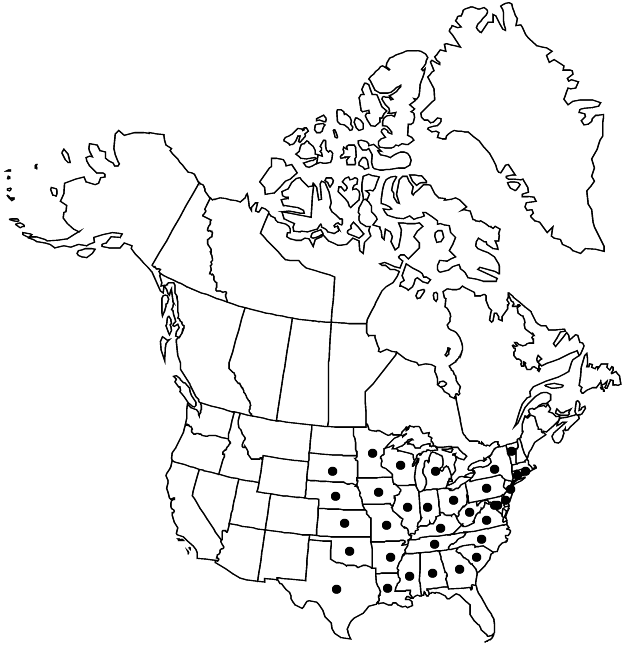Difference between revisions of "Silene stellata"
in W. Aiton and W. T. Aiton, Hortus Kew. 3: 84. 1811.
FNA>Volume Importer |
imported>Volume Importer |
||
| (One intermediate revision by one other user not shown) | |||
| Line 1: | Line 1: | ||
{{Treatment/ID | {{Treatment/ID | ||
|accepted_name=Silene stellata | |accepted_name=Silene stellata | ||
| − | |accepted_authority=(Linnaeus) | + | |accepted_authority=(Linnaeus) W. T. Aiton |
|publications={{Treatment/Publication | |publications={{Treatment/Publication | ||
|title=in W. Aiton and W. T. Aiton, Hortus Kew. | |title=in W. Aiton and W. T. Aiton, Hortus Kew. | ||
| Line 8: | Line 8: | ||
}} | }} | ||
|common_names=Starry campion;widow’s frill | |common_names=Starry campion;widow’s frill | ||
| + | |special_status={{Treatment/ID/Special_status | ||
| + | |code=E | ||
| + | |label=Endemic | ||
| + | }} | ||
|basionyms={{Treatment/ID/Basionym | |basionyms={{Treatment/ID/Basionym | ||
|name=Cucubalus stellatus | |name=Cucubalus stellatus | ||
| Line 48: | Line 52: | ||
-->{{#Taxon: | -->{{#Taxon: | ||
name=Silene stellata | name=Silene stellata | ||
| − | |authority=(Linnaeus) | + | |authority=(Linnaeus) W. T. Aiton |
|rank=species | |rank=species | ||
|parent rank=genus | |parent rank=genus | ||
| Line 61: | Line 65: | ||
|publication title=in W. Aiton and W. T. Aiton, Hortus Kew. | |publication title=in W. Aiton and W. T. Aiton, Hortus Kew. | ||
|publication year=1811 | |publication year=1811 | ||
| − | |special status= | + | |special status=Endemic |
| − | |source xml=https:// | + | |source xml=https://bitbucket.org/aafc-mbb/fna-data-curation/src/2e0870ddd59836b60bcf96646a41e87ea5a5943a/coarse_grained_fna_xml/V5/V5_423.xml |
|subfamily=Caryophyllaceae subfam. Caryophylloideae | |subfamily=Caryophyllaceae subfam. Caryophylloideae | ||
|genus=Silene | |genus=Silene | ||
Latest revision as of 22:11, 5 November 2020
Plants perennial; taproot thick; caudex branched. Stems several, simple proximal to inflorescence, 30–80 cm, puberulent, becoming subglabrous near base. Leaves withering proximally, in whorls of 4, ± sessile to short-petiolate, largest in mid-stem region; blade lanceolate to ovate-lanceolate, 3–10 cm × 4–40 mm, apex acuminate, puberulent on both surfaces, sparsely so adaxially. Inflorescences paniculate, open, bracteate, bracteolate, branches elongate, puberulent; bracts and bracteoles linear-lanceolate, 2–15 mm. Pedicels straight, often with 1 or 2 pairs of bracteoles, slender, 1/2–3 times calyx, glabrous or scabrous-puberulous. Flowers: calyx obscurely 10-veined, broadly campanulate, becoming obtriangular in fruit, 7–11 × 6–10 mm, herbaceous, margins dentate, very narrow, membranous, sparsely puberulent, lobes broadly triangular, 2–3 mm; corolla white, ca. 2 times longer than calyx, limb obtriangular, narrowed into claw, divided ca. 1/2 its length into 4–12 lobes, appendages absent; stamens equaling petals; styles 3, longer than petals. Capsules globose, opening by 3 broadly triangular teeth; carpophore 2–3 mm. Seeds dark brown, reniform, ca. 1 mm, papillate. 2n = (34), 48.
Phenology: Flowering summer.
Habitat: Rich deciduous woods, river flats, tall-grass prairies
Elevation: 0-1300 m
Distribution

Ala., Ark., Conn., Del., D.C., Ga., Ill., Ind., Iowa, Kans., Ky., La., Md., Mich., Minn., Miss., Mo., Nebr., N.J., N.Y., N.C., Ohio, Okla., Pa., R.I., S.C., S.Dak., Tenn., Tex., Vt., Va., W.Va., Wis.
Discussion
Silene stellata is a very distinct species with its broadly lanceolate leaves in groups of four at each node, and its brilliant white, multilobed petals. Two varieties are recognized by some workers: var. stellata, with glabrous pedicels; and var. scabrella, with scabrous pedicels. The former tends to have longer, more slender pedicels and be more common towards the northeast, whereas the latter tends to be more western. The correlation of characters and distribution is poor, however, and intermediate plants are often encountered.
Silene stellata was collected near the Grand River, Cambridge, Ontario, in 1941, but was probably introduced there and has not been seen since.
Selected References
None.